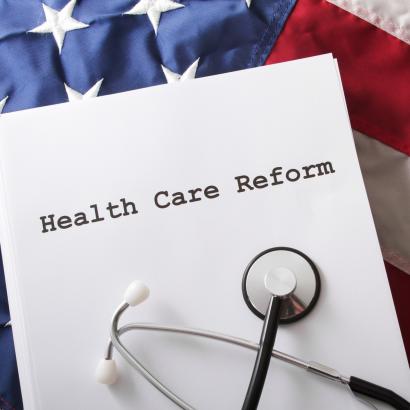Click here to download this proposal.
Federal healthcare subsidies for those under age 65 will total just over $1 trillion in 2023. Spending on Medicaid and the Affordable Care Act’s (ACA) premium subsidies will account for just over half that total. That spending is intended to ensure low- and middle-income families have access to medical care. Yet, while more is spent each year, the programs continue to underperform. To fix that, the Choices for All Project proposes state-level reforms that would empower recipients.
Key Plan Elements
- Ensure existing waiver authority is broadly available to facilitate innovative, state-based health reforms.
- Strengthen waiver authority rules to ensure continuity across administrations.
- Allow ACA recipients to select low-cost catastrophic plans with the remaining subsidy balance deposited into our newly proposed Individual Health Accounts (IHA).
- Provide Medicaid recipients with an option to receive partially funded IHAs—owned by the recipient—that can fully cover new cost-sharing requirements.
- Allow states to use waivers to pay for direct primary care (DPC) memberships for Medicaid enrollees.
Details
As the COVID-era expansions subside for Medicaid and the ACA, policymakers have an opportunity to rethink how Medicaid and the ACA work for remaining recipients. But rather than address the programs’ issues, policymakers have opted to expand the rolls, exacerbating the programs’ problems. That needs to change. Reforms should help ensure that both Medicaid and the ACA marketplaces work for enrollees, but one-size-fits-all federal reforms are unlikely to help. Instead, the Choices for All Project identifies necessary changes in federal policy and several related health reforms that states could champion.
Expand State Waiver Authority
States need more power to make Medicaid and the ACA work for enrollees. That requires taking full advantage of Section 1332 and Section 1115 waivers in existing laws.
Section 1332 State Innovation Waivers provide a promising avenue for states to improve healthcare access and affordability in their own unique ways. This flexibility gives states the ability to tailor their healthcare systems to their specific needs, which can lead to better outcomes for their residents. These waivers allow states to deviate from certain ACA provisions, so long as they can demonstrate that their alternative approach still meets certain goals set out in the law. Waivers must meet four “guardrails:”
- Comprehensiveness: The plan must provide coverage that is at least as comprehensive as that mandated under the ACA.
- Affordability: The plan must ensure that coverage is as affordable as it would be under the ACA.
- Scope: The plan must cover at least as many residents as the ACA provisions would.
- Deficit neutrality: The plan must not increase the federal deficit.
Federal policymakers should simplify the waiver application process to make it more transparent, while providing guidance and support to states seeking to implement innovative approaches to healthcare. Policymakers might also consider a provision that presumptively approves waivers that states certify will meet the existing Section 1332 guardrails. Finally, there should be a fast-track process for states that have already received a waiver and want to renew or modify it. This would allow states to bypass another lengthy application process and receive approvals more quickly.
The requirements for the approval of Section 1332 waivers should also be loosened to give states more freedom to design their own healthcare systems if they meet the overall goals of the ACA. States should be able to satisfy the scope guardrail by offering plans that are not as comprehensive as standard ACA plans. Importantly, they would still be required to offer other plans that met the comprehensiveness and affordability requirements.
Liberalizing and expanding the use of waivers still requires finding policies that can improve state health programs. Below we identify potential reforms that states could champion.
Expand Access to Catastrophic (Copper) Plans
Catastrophic insurance plans are rare in America, yet they make sense for many young and healthy Americans. These plans are often labeled “Copper” plans because insurance companies are expected to cover only 50 percent of expected health costs (compared to 70 percent for silver plans). The ACA clamped down on consumers’ freedom to choose catastrophic coverage. To be eligible, individuals need to be under age 30 or qualify for a hardship/affordability exemption. On top of that, tax credits for premiums are generally not eligible for the purchase of copper plans. Because of these issues, only about 1 percent of ACA enrollees choose a copper plan. Expanding access to copper plans to more individuals would fill an important need.
Offer Individual Health Accounts to ACA Recipients
Health Savings Accounts (HSAs) are not available for most ACA recipients. Plans offered on the ACA exchanges have cost-sharing rules that don’t meet the requirements of high-deductible health plans (HDHP), which are required if individuals wish to contribute to an HSA. The Choices for All Project proposes given ACA recipients to the newly proposed Individual Health Accounts (IHAs).
Unsubsidized ACA participants would face the same IHA contribution rules as employer-sponsored insurance (ESI) participants. They could make tax-free contributions to their IHA up to a maximum level, less the premiums they pay. For subsidized recipients, however, the tax benefits from making pre-tax IHA contributions would be minimal: few recipients earn enough to pay income taxes, particularly after accounting for premium tax credits. To ensure low-income Americans can benefit, states should be able to experiment with models in which federal and state contributions are deposited into a recipient’s IHA.
For more information, read our proposal on creating Individual Health Accounts.
Individual Health Accounts for Medicaid Recipients
Individual Health Accounts could be made available to Medicaid recipients through Section 1115 waivers. Currently, federal rules force most Medicaid recipients into a one-size-fits-all system of health. Choice is minimal. IHAs offer an opportunity to empower these recipients. We propose states pursue experiments that offer Medicaid recipients the option to have an IHA with contributions made to the account by the state’s Medicaid Program. In exchange, states would increase cost-sharing requirements one-for-one with the contributions made. Exemptions from cost-sharing could be made for certain preventive services. Importantly, the requirements would include annual out-of-pocket maximums that match the annual contribution to the recipients IHA. This ensures recipients would not be made worse off and the total spending per recipient would remain the same.
Direct Primary Care for Medicaid Recipients
With the rapid growth of Medicaid Managed Care Organizations contracting with state governments to cover enrollees for a capitated cost, finding ways to reduce the growth of per capita Medicaid spending is in the federal and each state government’s interest. States could obtain waivers to experiment with offering Direct Primary Care coverage to Medicaid enrollees, either as a carve out from existing per capita spending or on top of traditional coverage. The goal would be to lower long-term per capita Medicaid spending by having direct primary care needs covered at a much lower cost than in existing arrangements.
















